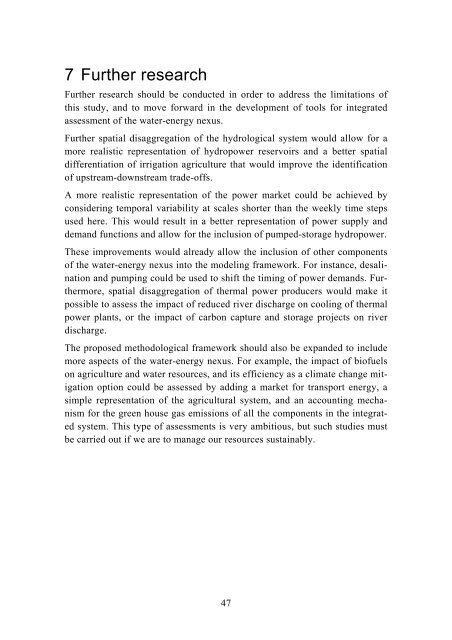A framework for joint management of regional water-energy ... - Orbit
A framework for joint management of regional water-energy ... - Orbit
A framework for joint management of regional water-energy ... - Orbit
You also want an ePaper? Increase the reach of your titles
YUMPU automatically turns print PDFs into web optimized ePapers that Google loves.
7 Further research<br />
Further research should be conducted in order to address the limitations <strong>of</strong><br />
this study, and to move <strong>for</strong>ward in the development <strong>of</strong> tools <strong>for</strong> integrated<br />
assessment <strong>of</strong> the <strong>water</strong>-<strong>energy</strong> nexus.<br />
Further spatial disaggregation <strong>of</strong> the hydrological system would allow <strong>for</strong> a<br />
more realistic representation <strong>of</strong> hydropower reservoirs and a better spatial<br />
differentiation <strong>of</strong> irrigation agriculture that would improve the identification<br />
<strong>of</strong> upstream-downstream trade-<strong>of</strong>fs.<br />
A more realistic representation <strong>of</strong> the power market could be achieved by<br />
considering temporal variability at scales shorter than the weekly time steps<br />
used here. This would result in a better representation <strong>of</strong> power supply and<br />
demand functions and allow <strong>for</strong> the inclusion <strong>of</strong> pumped-storage hydropower.<br />
These improvements would already allow the inclusion <strong>of</strong> other components<br />
<strong>of</strong> the <strong>water</strong>-<strong>energy</strong> nexus into the modeling <strong>framework</strong>. For instance, desalination<br />
and pumping could be used to shift the timing <strong>of</strong> power demands. Furthermore,<br />
spatial disaggregation <strong>of</strong> thermal power producers would make it<br />
possible to assess the impact <strong>of</strong> reduced river discharge on cooling <strong>of</strong> thermal<br />
power plants, or the impact <strong>of</strong> carbon capture and storage projects on river<br />
discharge.<br />
The proposed methodological <strong>framework</strong> should also be expanded to include<br />
more aspects <strong>of</strong> the <strong>water</strong>-<strong>energy</strong> nexus. For example, the impact <strong>of</strong> bi<strong>of</strong>uels<br />
on agriculture and <strong>water</strong> resources, and its efficiency as a climate change mitigation<br />
option could be assessed by adding a market <strong>for</strong> transport <strong>energy</strong>, a<br />
simple representation <strong>of</strong> the agricultural system, and an accounting mechanism<br />
<strong>for</strong> the green house gas emissions <strong>of</strong> all the components in the integrated<br />
system. This type <strong>of</strong> assessments is very ambitious, but such studies must<br />
be carried out if we are to manage our resources sustainably.<br />
47
















